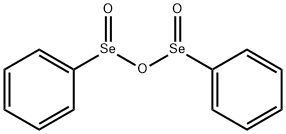General Description
Oxidation of phenols by benzeneseleninic acid anhydride yields
ortho-quinones. Benzeneseleninic anhydride acts as a mild oxidant for the conversion of benzylic hydrocarbons into aldehydes or ketones.
Purification Methods
When the anhydride is recrystallised from *C6H6 it has m 124-126o, but when this is heated at 140o/1hour in a vacuum or at 90o/2hours it has m 164-165o and gives a solid m 124-126o when then recrystallised from *C6H6. Both depress the melting point of the acid PhSeO2H. If the high melting anhydride is dissolved in *C6H6 and seeded with the high melting anhydride, the high melting anhydride crystallises out. It readily absorbs H2O to form the acid (PhSeO2H, m 122-124o). Because of this the commercial anhydride could contain up to 30% of the acid. It is best purified by converting to the HNO3 complex (m 112o) and heating this in vacuo at 120o/72hours to give the anhydride as a white powder m 164-165o. Alternatively heat the anhydride in vacuo at 120o/72 hours until the IR shows no OH band. [Ayvrey et al. J Chem Soc 2089 1962, Barton et al. J Chem Soc, Perkin Trans 1 567 1977, Beilstein 11 H 422, 11 I 110, 11 III 716, 11 IV 708.] TOXIC solid.




